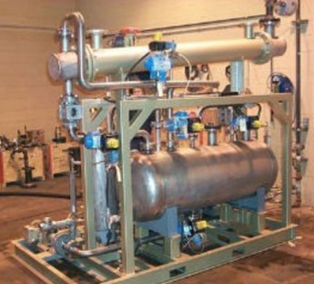An alternative to solvent replacement, as a mechanism to reduce cost and waste, is in–process solvent recovery utilizing vacuum technology. The usage of solvent vapor recovery equipment incorporating vacuum pumps and condensate receivers is economically preferable to raw materials substitution.
Industries such as chemical, pharmaceutical, metal powders, flavor and fragrance, and PET solid-state manufacturing use solvent recovery vacuum systems. For example, the solvent recovery process is typically as follows:
 A solvent is oftentimes present in a liquid mixture with the desired product.
A solvent is oftentimes present in a liquid mixture with the desired product.- Applied heat and/or vacuum vaporizes the solvent.
- Our systems condense and store the solvent in a vacuum receiver or drain directly into a liquid ring vacuum pump.
- Accumulated solvent is pumped or drained to a solvent storage tank.
Solvent recycling vacuum systems are regularly used in conjunction with the following types of process equipment:
- Vacuum Dryers
- Batch Reactors
- Granulators
Wintek generally utilizes liquid ring vacuum pumps sealed with one of the solvents in the incoming process stream to maximize recovery and reduce potential contamination/environmental concerns.
The complexity associated with utilizing a solvent-sealed vacuum system is the calculation of the size of the liquid ring vacuum pump, as well as understanding how different solvent properties affect a pump’s performance. Liquid ring vacuum pumps sealed with a solvent other than water require advanced sizing calculations that most organizations are unable to perform. Wintek utilizes proprietary internally-developed liquid ring vacuum pump sizing software to size and design solvent-sealed process vacuum systems.
Wintek has experience designing for and helping customers recover the following solvents:
| Aniline | DiMethyl-Carbonate | Methyl Ester-Soy |
| Benzene | D-Limonene | Methyl Methacrylate |
| Butane | DMS LHC FT | Methylene Chloride |
| Butanol | Furfural | Methyl Isobutyl Ketone (MIBK) |
| Butyl Acetate | Glycerol | Mineral Spirits |
| Carbon Tetrachloride | Heptane | Propanol |
| Chlorobenzene | Hexane | Propylene Oxide |
| Dethylamine (DEA) | Hexene | Styrene |
| Dibutylamine (DBA) | IsoPar C | Tetrahydrofuran |
| DiChloroMethane (DCM) | Isopropyl Alcohol (IPA) | Therminol |
| Dimethyl Acetamide | Methyl Ethyl Ketone (MEK) | Toluene |
| Dimethyl Formamide (DMF) | Methanol | Vinyl Acetate |
| Dimethyl Sulfoxide (DMSO) | Methyl Acrylate | Water |
| Dimethylamine (DMA) | Methyl Chloride | Xylene |
